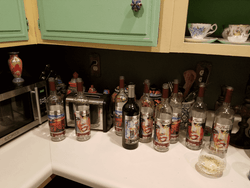Enjoying a good glass of wine is always the goal. However, there are so many things that we seem to need to consider when we’re faced with the thought of opening up a bottle. Seems like it’s just one more thing, I know. But once you have an idea of what to look for and what to do, your wine tasting experiences will just be that much better. My dad used to always say to me… “Son, just open the bottle and poured in a glass. What is more to it than that?” LOL Well, anyone who struggled with a crumbling cork, listen to a debate over whether the Cabernet their drinking needs to breathe more or finds the taste of a wine change 15 minutes after it was opened, you’ll know there’s something you need to know.
Decanting of a wine is one of those elements that seems to remain a bit intimidating to most wine drinkers. Honestly, before I got into wine, I had absolutely no clue what the idea of the canteen even meant. Honestly, I thought it was just a bit of pop and circumstance that made you look smart. So rest assured, you are in good company. After a few years, however, after I got to know what decanting was all about, it became one of my best tools for bringing out the true characteristics of the wine.
Here are my thoughts on a few things every great wine enthusiast should know about the decanting.
In short, decanting a wine serves two great purposes: to separate a wine from any sentiment that may have formed and to add oxygen to the wine to help it open up and produce the proper aromas and flavors you’re expecting.
Dealing with sediment in your bottle
let’s deal with the sentiment first. Older red wines and vintage ports naturally produce sediment as they age. White wine doesn’t really do this. So it’s very rare to decant a white wine in order to remove sediment. The color pigments and tannins bond together and fall out of solution. if you should stir up the sediment and pour it into a glass it will cloud the wine’s appearance and impart bitter flavors in a gritty texture. No, the sediment is not harmful but who wants to have a gritty wine?
The decanting of your wine is simply the process of separating the sediment from the wine. It is very safe to assume that any red wine will have accumulated sediment after five or 10 years in the bottle. It’s very hard to verify this visually but the first rule of thumb is to go by the age of the wine. If you have a bottle that’s over 5 years old, chances are is going to be a bit of sediment. So as rule of thumb, always decant older wines.
How to Decant your bottle of wine
Here are my 7 steps to decanting a wine to remove the sediment.
-
If you have the time, set your ball upright for at least 24 hours or more before drinking. This will naturally allow the sediment the slide to the bottom of the bottle. It makes it much easier to separate the sediment from the wine when you have done this.
-
Find a decanter or other clean glass from which the wind can easily be poured into.
-
remove the capsule or cork and wipe the bottleneck clean.
-
Pour the wine into the decanter slowly and steadily. It’s important not to rush this process. It’s also important not to stop the pouring of the wine into the decanter after you have started the process. When you get to the bottom of the bottle pour it even more slowly. You want the sediment to stay in the bottle only the wine to go into the decanter.
-
As Soon as you see the sentiment reach the neck of the bottle, stop. It might be a good idea to use a flashlight and pointed onto the neck of the bottle as you are preparing to see when the sediment rises to the top. Sediment is not always chunky or obvious. Be sure to stop the wind’s color becomes cloudy or PC what looks like speckles of dust around the neck.
-
It is always a good practice to leave about 1 ounce in the bottle that you will discard.
-
The wine is now ready to serve. Drink away.
Decanting your wine to oxygenate it
This is probably one of the main reasons I enjoy my decanter so much. Adding air to a wine simply opens it up and brings it alive. The question of whether, or how long to aerate a wine can generate extensive debate amongst wine professionals. Some feel adding extra oxygen opens up the wine and gives it extra life, as I do. If you have ever opened a bottle of wine and it seems unimpressive at the first taste, it’s a clear indication that a little oxygen can bring life to that bouquet. It’s very hard to moderate the amount of air you put into a wine in order to get an idea as to what you like best. However, a decanter will always add value to any wine engages. Yes, just opening the bottle and let it breathe for a little while can do the same as a decanter. However, good decanter can cut the time for the wine to open up so you can get busy drinking.
There are many that believe that the canteen wine makes it fade faster and that wine exposed to oxygen in the swirl of your glass is more than enough. Honestly, it’s totally up to you. It’s true that there are some wines I will never decant. I’ve seen many winds just become tall and saturated after a good decanting. It really is up to the wine you are drinking and how you like to engage the flavor.

Here are a few rules of thumb to consider
- A particularly fragile or old wine that is 15 or more years of age should be for no more than 30 minutes before drinking.
- A younger, more vigorous or full-body red wine (even some whites) can be decanted for an hour or more before serving.
- Experiment with time and the wine. That’s the only way you’re going to find out what you like.
Some friends of mine and I recently acquired an iFavineSmart Decanter. WOW! That is all I can say. We found this unit on Amazon and it has an amazing skill. It takes the time required to decant the wine reduces it dramatically. For example, to decant a wine for 30 minutes will only take this unit for 30 seconds. I love this unit and it is honestly the best way to experiment with how long a wine should be decanted. I took every single one of our bottles and ran it through this machine at various times. It really helped me understand how the wine tasted in 30 minutes or in two hours. They are not cheap. But if you are a strong wine enthusiast, it’s most certainly something you’re going to want to pick up.
So, pick up a few bottles, experiment with them and enjoy the taste.
Cheers!
Jason McClain, Proprietor
McClain Cellars





